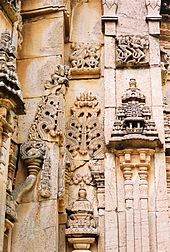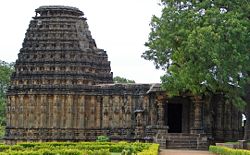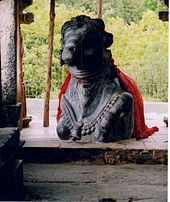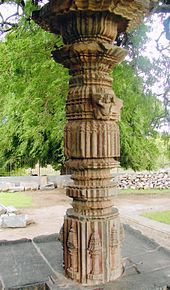- Doddabasappa Temple
-
Dodda Basappa Temple at Dambal, a unique 24-pointed, uninterrupted stellate (star-shaped), 7-tiered dravida plan, 12th century CE

The Doddabasappa Temple is a 12th century Western Chalukyan architectural innovation in Dambal, Karnataka state, India. The temple is about 20 km (12 mi) southeast of Gadag city and 24 km (15 mi) southwest of Ittagi in Koppal district.[1] The sanctum contains a Shiva linga, the symbol of the presiding deity, God Shiva. The temple interior is a standard construction and consists of a sanctum (cella), a vestibule (antarala) and a main mantapa (also called navaranga or hall). The vestibule connects the sanctum to the mantapa.[2] The Western Chalukya monuments, regional variants of existing dravida (South Indian) temples, defined the Karnata dravida architectural tradition.[3][4]
Contents
Temple plan
Stellate plan
The temple is based on a very original 24-pointed uninterrupted stellate (star shaped) plan and uses soapstone as its basic building material.[5] Contemporary stellate plans of the Bhumija shrines in central India from where the inspiration for this temple came from, were all 32-pointed interrupted types. No temples of the 6-, 12-, or 24-pointed stellate plans are known to exist in Karnataka or Maharashtra, with the exception of the Doddabasappa temple, which can be described as a 24-pointed uninterrupted plan.[5] (In an 'interrupted' stellate plan, the stellate outline is interrupted by orthogonal (right-angle) projections in the cardinal directions, resulting in star points that have been skipped.[6])
The Doddabasappa temple marks the mature development of the Chalukyan art which originated from basic dravida architecture of South India. Its departure from conventional dravida plan used in the Virupaksha temple in Pattadakal is so extreme that it would be very difficult to find similarities without detailed examination.[1] A star shape is obtained by rotating a square about its centre. The star points form equidistant projections. The angles and re-entrant angles thus formed make the perimeter of the outerwall of the shrine.[1]
The star projections are carried right up the superstructure (tower over the shrine — Sikhara), giving it an exotic look, though it loses strength in comparison to the square superstructures found in conventional dravida plans. The storied arrangement of the superstructure found in dravida plans is not easily distinguishable here.[7] The upper tiers of the seven-tiered (tala) superstructure look like cogged wheels with 48 dents.[8]
Other details
 Wall relief in projections and recesses: Kirtimukha, Pilasters and dravida style miniature towers (aedicule)
Wall relief in projections and recesses: Kirtimukha, Pilasters and dravida style miniature towers (aedicule)
The pillars in this temple are finely chiseled and "complicated" but lack the elegance of those at the Kasivisvesvara Temple in Lakkundi.[7] The entrance to the shrine has above it a decorative architrave with space for images (now missing) of the Hindu Gods Brahma, Vishnu and Shiva. Depending on the dedication of the temple, either Vishnu or Shiva would take the central position in this arrangement.[7] The entrance to the sanctum is elaborately decorated on either side with designs that are floral containing tiny images of dancers, musicians and even a mithuna couple (Gemini). In the main mantapa (hall) there are three images, one of the "five headed" Brahma and his vehicle (vahana), the goose, and two images are of Surya, the Sun God.[7]
The temple has two doorways each with a porch, one facing south and the other facing east. The east facing door has on either side the remains of what must have been elegant lintel decoration, and an open hall type of pillared extension containing a large recumbent image of Nandi (bull) which faces the shrine.[2][7]
Notes
- ^ a b c Cousens (1926), p. 114
- ^ a b M.S. Dwarakinath. "THE CHALUKYAN MAGNIFICENCE". Spectrum. Deccan Herald. http://archive.deccanherald.com/CONTENT/Oct232007/spectrum2007102231808.asp. Retrieved 2008-05-14.
- ^ Hardy (1995), pp. 6–7
- ^ Hardy, Adam. "Indian Temple Architecture: Form and Transformation, the Karnata Dravida Tradition, 7th to 13th Centuries". Artibus Asiae, Vol. 58, No. 3/4 (1999), pp 358–362. JSTOR. http://links.jstor.org/sici?sici=0004-3648(1999)58%3A3%2F4%3C358%3AITAFAT%3E2.0.CO%3B2-F. Retrieved 2007-11-28.
- ^ a b Foekema (2003), p. 60
- ^ Foekema (2003), p. 63
- ^ a b c d e Cousens (1926), p. 115
- ^ Foekema (2003), p. 61
References
- Cousens, Henry (1996) [1926]. The Chalukyan Architecture of Kanarese Districts. New Delhi: Archaeological Survey of India. OCLC 37526233.
- Foekema, Gerard (2003) [2003]. Architecture decorated with architecture: Later medieval temples of Karnataka, 1000–1300 AD. New Delhi: Munshiram Manoharlal Publishers Pvt. Ltd. ISBN 81-215-1089-9.
- Hardy, Adam (1995) [1995]. Indian Temple Architecture: Form and Transformation-The Karnata Dravida Tradition 7th to 13th Centuries. Abhinav Publications. ISBN 8170173124.
Coordinates: 15°19′41″N 75°48′37″E / 15.32806°N 75.81028°E
Hindu Temples in Karnataka Amrutesvara Temple, Amruthapura • Annapoorneshwari Temple • Annigeri • Antara Gange • Badami Cave Temples • Balligavi • Banashankari Amma Temple • Banashankari Temple Amargol • Bhutanatha group • Chamundeshwari Temple • Chamundeswari Temple • Chandramouleshwara Temple • Chaudayyadanapura • Cheluvanarayana Swamy Temple • Chennakesava Temple • Chennakesava Temple, Somanathapura • Chitrapur Math • Chowdeshwari Temple • Devarayana Durga • Dharmaraya Swamy Temple • Dharmasthala Manjunatha Temple • Dodda Ganeshana Gudi • Doddabasappa Temple Dambal • Gadag-Betigeri • Kalakaleshwara Temple Gajendragad • Galaganatha • Gavi Gangadhareshwara Temple • Godachi • Gokarnanatheshwara Temple • Halasi • Halasuru Someshwara Temple • Hangal • Harihareshwara Temple • Panchalingewara Temple Hooli • Hoysaleswara Temple • Hulimavu cave Temple • Idagunji • Ikkeri • Ishvara Temple, Arasikere • Itagi Bhimambika • Kadri Manjunath Temple • Kalasa • Kalghatgi • Kalikamba Temple • Kamala Narayana Temple Belagavi • Kanakagiri • Karighatta temple • Karikanamma • Kasivisvesvara Temple, Lakkundi • Keladi • Keshava Temple • Kodandarama Temple • Kotilingeshwara • Krauncha Giri • Kudalasangama • Kudroli Bhagavathi • Kukke Subramanya Temple • Kuknur • Kumara Swamy Devasthana, Bangalore • Kundgol • Kurudumale • Lakkundi • Lakshmeshwar • Lakshmi Devi Temple, Doddagaddavalli • Lakshmi Narasimha Temple, Bhadravathi • Lakshmi Narasimha Temple, Nuggehalli • Lakshminarayana Temple, Hosaholalu • Mahabaleshwar Temple, Gokarna • Maha Ganapathi Mahammaya Temple • Mahadeva Temple, Itagi • Mahakuta group of temples • Mandarthi • Mangaladevi Temple • Maranakatte • Mariyamma Temple • Melukote • Mookambika Temple Sirsi • Mudukuthore • Mundkur Sri Durgaparameshwari Temple • Murudeshwara • Mylara Lingeshwara Temple at Mylara • Nandi Temple • Navalinga Temple • Nellitheertha Cave Temple • Padutirupathi • Pattadakal • Ragigudda Anjaneya Temple • Ranganathaswamy Temple, Bangalore • Saundatti • Shree Vishnumurthy Temple • Shri Vinayaka Shankaranarayana Durgamba Temple • Shringeri • Shringeri Sharadamba Temple • Siddhesvara Temple Haveri • Srikanteshwara Temple, Nanjangud •Sirsangi Kalika Temple • Someshwara • Sri Ranganathaswamy Temple, Shivanasamudra • Sri Ranganathaswamy Temple, Srirangapatna • Sudi • Shree Sharavu Sharabheshwara Kshetra- Sri Mahaganapathy Temple • Talagunda • Talakad • Tamboor • Temples in Tulunadu • Temples of North Karnataka • Thirunarayanapuram • Trikuteshwara Temple Gadag • Tripurantaka Temple • Udupi Sri Krishna Matha • Veera Narayana Temple, Belavadi • Virupaksha Temple • Western Chalukya temples • Yediyur Siddhalingeshwara Swamy Temple • Yelluru Shri Vishweshwara Temple
Categories:- Hindu temples in Gadag district
- 12th-century architecture
- Chalukya dynasty
- Western Chalukya Empire
- Temples in Karnataka
- Tourism in Karnataka
Wikimedia Foundation. 2010.




